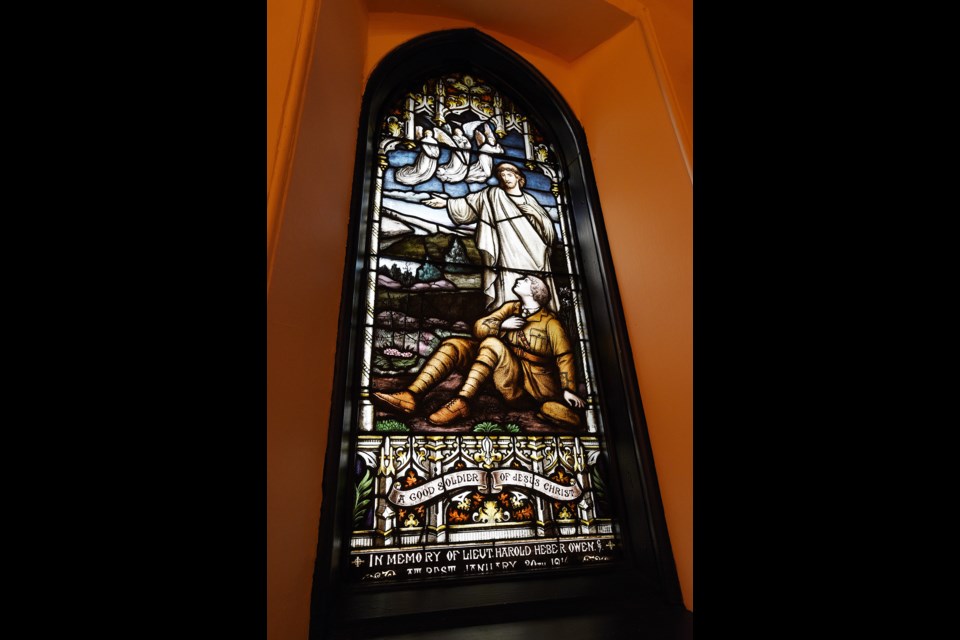Sunlight glints through it some days, the grieving love right there on the east wall of Christ Church Cathedral, embedded in a stained glass window.
Given for a young man dead in the mud of Flanders in 1916, the window in the downtown Anglican church remembers day after day Lt. Harold Heber Owen, son of the church’s third rector, Cecil Caldbeck Owen, and his wife Alice.
In another Anglican church, St. George’s, near Vancouver General Hospital where Cecil served as chaplain for 25 years, a second window holds grieving love tripled: St. George and Sir Galahad memorialize the Owens’ adopted son, Luder Keshishian Owen, and their grandson, Charles Harold Owen Hamilton, both dead in the Second World War.
The story of those lost lives could start in 1864 — Cecil was born in England, and Alice in Ontario.
Cecil arrived in Canada in 1883, studying for the ministry in Toronto. He and Alice married in 1891. Harold was born in 1893 and then four daughters joined the family. In 1903, Cecil came west, accepting the post at Christ Church.
When Britain declared war on Aug. 4, 1914, Harold, home on holiday from medical school in Toronto, promptly signed up. His attestation papers describe a young man, five-feet, seven-and-a-half inches tall, with blue eyes, medium dark hair, and a small scar on his right crown.
A surplus of officers at the Valcartier, QC mustering grounds raised doubts about speedy deployment overseas. So Harold resigned his lieutenant’s commission, taking a sergeant’s post in the ambulance corps and serving through the first gas attack at Ypres in April 1915.
Cecil took an overseas appointment as a military chaplain that same month.
Harold regained his commission in June 1915. He was killed near midnight on Jan. 30, 1916 by a rifle shot to his head while covering the retreat of a small party of his men whom he had led through No Man’s Land to the German wire. He was 22 years old. Cecil’s telegram home read: “Harold is promoted to service with God.”
After conducting four burial services for his battalion, Cecil rode for three hours to his son’s funeral. On Harold’s gravestone in Ploegsteert, Belgium are the words from 2 Timothy 2:3: “A Good Soldier of Jesus Christ.”
A soldier in battle dress, and those markers of the Western Front, barbed wire, a blighted tree, and sandbags, illustrate Harold’s window. A Good Soldier of Jesus Christ, reads the inscription.
Grandson Charles was born January 1922, a second child for Winnifred Hamilton, the oldest Owen daughter. The 1940 U.S. census found Charles in high school in Seattle. His occupation? Mowing lawns.
Twelve-year-old Luder Keshishian, orphaned in the Turkish persecution of Armenians, arrived from Beirut at the Owens’ home in February 1929, speaking, apparently, no more than a smattering of English, in a city that contained no other Armenians.
He was a bright, athletic boy, winning the 1935 citizenship award at Vancouver Technical School, and the 1936 academic medal in his grade twelve year.
The 1936 VanTech yearbook reads: “Tudor’s favourite saying is ‘By golly.’ Captain of senior rugby team, an all-round athlete, not interested in girls (says he), and always heard singing (?) during drafting periods. Top notcher in his class.”
Charles enlisted in the U.S. Navy in November 1940, serving as radioman and rear gunner. He died, one day short of his 21st birthday, at 3:30 a.m. on Jan. 13, 1943 during a training exercise. His plane crashed into the harbour of Espiritu Santo Island, the largest island of Vanuatu, north-east of Australia. He left behind his widow, Josephine, also just 20.
Luder had joined the Royal Canadian Air Force in June 1938. His Stirling aircraft took off from Norfolk at 2325 hours on June 24, 1944, heading for northern France to take out a V1 flying bomb launch site. The plane was shot down by a German night fighter; the seven crew members were buried in a collective grave in the village of Fruges. Luder was 27.
On his grave stone today are the words: “Good Soldier of Jesus Christ.”
At St. George’s, where the Owens had been long-time parishioners, the RCAF insignia and its motto, Per Ardua Ad Astra (Through Adversity to the Stars), mark Luder’s section of the window, with the USN insignia at the bottom of Charles’s panel. Anchoring the centre panel, with the Good Samaritan story, are the words: “A Good Soldier of Jesus Christ.”
The window was consecrated in May 1946. The music that day tied the three young men together. The solo, “Crossing the Bar,” and the recessional hymn, “Fight the Good Fight,” had been favourites of Harold, sung at services dedicated to his memory at Christ Church 30 years earlier.
Alice died in September, 1953 and Cecil died Christmas Eve, 1954. The windows remain, honouring two generations, three lives.
Anne Fletcher’s play, Duty Calls - Men of Christ Church Go To War with Harold Owen as one of the characters, will be performed at Christ Church Cathedral Nov. 10 at 7 p.m. Check
thecathedral.ca for details.



